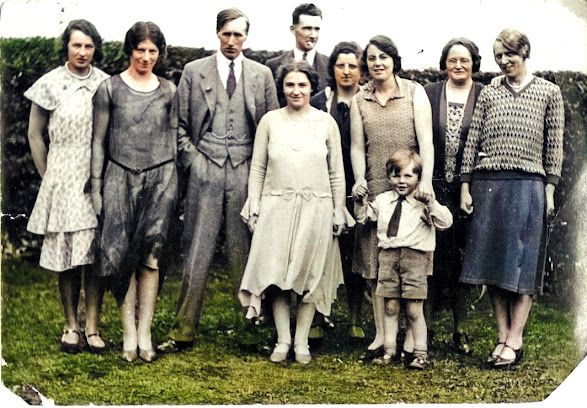Now it's November and although the leaves are still on the trees it is time to light the log burner in the evenings. We are still picking up windfall apples- which the pheasants are enjoying too - but soon surely we will have a frost and they will get frozen.
This blog post is about Eastrington, the village where I was brought up and my ancestors inhabited for well over 350 years.
I have always been interested in local history and some few years ago now wrote a comprehensive history of the village which I have sent all over the world to descendants of Eastrington residents. I still have plenty of copies for sale. You can buy them either from Chappelows in Howden or the hair salon in Eastrington
I have recently kindly been given a lot of pictures by Mrs Doreen Wilde who has moved away from Howden and wished her pictures to 'stay local'. Mrs Wilde, before her marriage to Frank, was Doreen White and was brought up at Eastrington brickyard. Her parents, Cecil and Louie lived there and Cecil ran the brickyard, succeeding his father Walter.
The brickyard at Eastrington had come into being when the Hull and Selby railway was built [it opened in 1840] and a seam of clay was found during the construction. The land, Stone bridge close, which became the brickyard, had once belonged to my ancestor George Wise Nurse who built and lived in The Laurels.
An early owner of the brickworks was Richard Graves, a Broomfleet brickmaker who built two cottages on the 10 acre site. He sold it to John Watson in 1855 who was the older brother of George Slater's wife Jane. George and Jane already lived in one of the cottages and lived at the brickyard for the rest of their lives.
The brickyard remained in the extended Watson family until it was bought by another brickmaker Johnson Ducker of Melton in the parish of North Ferriby. Johnson's daughter Elizabeth had fallen in love with a young railwayman, originally from Devon called Walter White. The young couple married in 1896 and their son Stephen Ducker White was born in 1897, followed by Maria and Dorothy.
Walter was still working as a signalman but soon afterwards his father in law bought the Eastrington brickyard and the family moved there with Walter Cecil and Catherine being born at the brickyard.
Then came the First World War and Stephen joined up. He was awarded the Military Medal as reported in the Hull Daily Mail of 29th December 1917.
EASTRINGTON'S FIRST MILITARY MEDALLIST. Bombardier Stephen White, R.F.A., M.M. son of Mr and Mrs W. White, Stonebridge House, Eastrington, who lias been awarded the Military Medal for gallantry in action, is the first of Eastrington's sons to win distinction in the field.
Bombardier White, who has been attached to the Battery as gun layer since May, 1916, and was early in present promoted, has been for many months in the thick of the fighting, including at Cambrai. Writing home, he says:
"We have had all awful experience, and I thought we had already seen all the horrors of battle; but it was nothing in comparison to this. Really, I had no time to think until was over. The following day the C.O. came whilst I was working the gun, and said he had selected me to go to artillery school down the line, where 1 should get rest from this for a while. Whilst on parade a few days later the officer called me out and toldme J had won the Military Medal for devotion to duty and work done on November 30th."'
Bombardier White was educated the Hull Grammar School, and at the time of joining H.M. Forces 1915, was hon. secretary of the Eastrington Wesleyan Sunday School. He was drafted to Ireland, where he went for examination in gun laying, and out of ten candidates he was the only one who obtained t.he maximum marks of 100. He is a grandson of the late Mr Johnson Ducker, of North Ferriby.
Stephen later settled at Newland where his family still live today.
Walter White built four houses on the north side of Howden Road for his family and the brickyard supplied bricks and tiles for many local building projects as well as drainpipes for local farmers.
It eventually passed to Walter's son Cecil and then when he retired it was bought by the Howden Rural District Council and used as a refuse tip. This became something of a problem as there was often a pall of smoke from it over the village and it became a magnet for scrap dealers who swarmed over the tip and parked in the lanes nearby.
In 1976 the council proposed buying the old railway ponds to dump more rubbish in and there were many objections. At the time my mother, Joan Watson, was both a local teacher and parish councillor. She often took her classes on nature walks down Westfield Lane and I remember her, with the other councillors, showing representatives from the then Boothferry council round the site and proposing it as a nature reserve.
And of course it is now a very popular local amenity.
Walter White and his family were staunch supporters of Eastrington chapel which sadly recently closed. Its history will be the subject of a later post.
If anyone is interested in seeing a slide show of the village I shall be showing pictures in Skelton village hall at 1.30 on Monday 21st November to the small local history group which meets there. If you would like to come please contact me for details on howdenshirehistory.co.uk as it is only a small hall!!!
 |
Eastrington brickyard |
 |
| Eastrington brickyard |
 |
| Walter and Elizabeth White |
